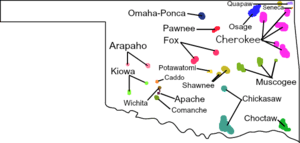Quapaw language facts for kids
Quick facts for kids Quapaw |
|
|---|---|
| Arkansas, O-gah-pah | |
| Native to | United States |
| Region | Arkansas, Oklahoma |
| Ethnicity | 160 Quapaw (2000 census) |
| Native speakers | 1 (2019) (date missing) |
| Language family |
Siouan
|

Map showing the distribution of Oklahoma Indian Languages
|
|
The Quapaw language, also called Arkansas, is a special language. It belongs to the Siouan language family. The Quapaw people originally spoke it in what is now Arkansas. Today, it is mostly spoken in Oklahoma.
Quapaw is similar to other languages in the Dhegiha group. These include Kansa, Omaha, Osage, and Ponca.
Learning About the Quapaw Language
The Quapaw language has been studied and written down for a long time. Many people have helped document it. For example, George Izard wrote notes in 1827. Lewis F. Hadly also made notes in 1882. A linguist named James Owen Dorsey studied it in the 1800s. Later, Frank T. Siebert worked on it in 1940. Robert Rankin also studied the language in the 1970s.
It can be tricky to write Quapaw using English sounds. Because of this, there isn't one official way to write it. Different researchers used different writing systems. This makes it hard for new learners to understand. To help, an online dictionary is being created. It brings together all the known information. This dictionary uses a special alphabet called the International Phonetic Alphabet. This alphabet helps show how the sounds are made.
Bringing the Quapaw Language Back
Efforts are being made to help the Quapaw language grow again. This is called language revitalization. Ardina Moore used to teach Quapaw language classes. She taught them through the tribe. As of 2012, you can find Quapaw lessons online. They are also available on DVD.
There is an online audio dictionary for Quapaw. It is on the tribal website. This dictionary helps people learn the language. It includes recordings of people who spoke Quapaw as their first language. These speakers were born between 1870 and 1918.
In 2012, the 2nd Annual Dhegiha Gathering took place. Speakers from Quapaw, Osage, Kaw, Ponca, and Omaha came together. They shared ideas on how to bring their languages back. The Quapaw Tribe also has a Youth Language and Cultural Preservation Camp. This camp teaches the language to children. Adults can take classes at the Quapaw Tribal Museum.

